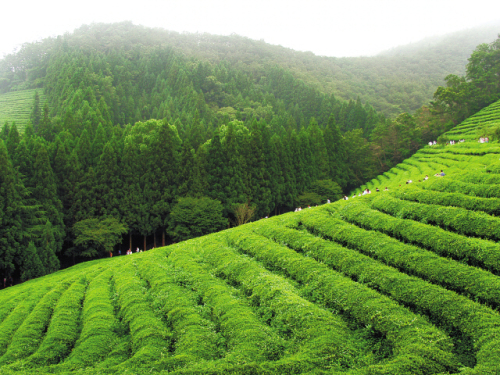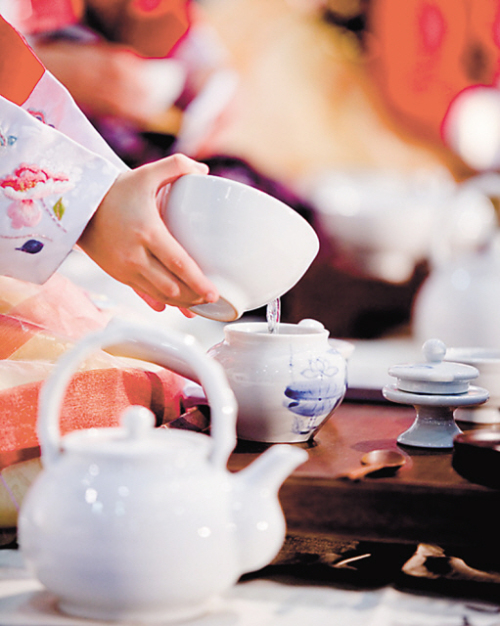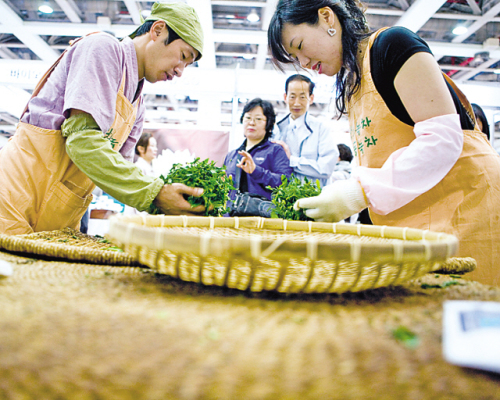Sip, celebrate, and learn: Ways to enjoy Korean green tea
By Claire LeePublished : May 11, 2012 - 19:28

A guide to appreciating Korean tea and culture
It’s been almost a month since the first picking of green tea leaves took place in Korea.
For those who are familiar with the well-known tea cultures of India, China, or Japan, it may be a surprise to discover Korea also has a rich history of tea ceremonies.
Known as “darye” in Korean, the ceremonies have been practiced for some 2,000 years, since the time of the ancient Gaya Kingdom (A.D. 42-562).
It’s been almost a month since the first picking of green tea leaves took place in Korea.
For those who are familiar with the well-known tea cultures of India, China, or Japan, it may be a surprise to discover Korea also has a rich history of tea ceremonies.
Known as “darye” in Korean, the ceremonies have been practiced for some 2,000 years, since the time of the ancient Gaya Kingdom (A.D. 42-562).

May is the perfect month to enjoy all aspects of Korea’s tea making and drinking ― it’s the busiest season for tea leaf picking. On top of that, the Daegu Tea Expo, one of the biggest tea-themed events here, is kicking off next week.
The weather is perfect for enjoying tea outdoors, and even picking the leaves and roasting them yourself.
Here is your guide to exploring the world of Korean green tea, from tea-themed festivals to darye classes.
Celebrate it
For green tea lovers, Daegu would be the ideal place to be next weekend. The 2012 Daegu Tea Expo, which is being held in the city from May 17-20, offers a variety of programs for anyone interested in Korean tea culture.
Some 800 experts in Korea’s traditional tea ceremonies will be participating, representing 60 different organizations. They will be demonstrating the traditional customs and rituals.

If you are a collector of tea paraphernalia ― from teacups and pots to saucers and strainers ― don’t miss out on the event’s special exhibition which showcases some 100 pieces of traditional tea equipment.
There also will be a hanbok fashion show, a reenactment of a traditional wedding ceremony, as well as an academic forum about international tea drinking culture.
The event also features drinks from other countries, including coffee and other types of tea. For more information about the upcoming event, visit http://www.tea-festival.kr or call (053) 768-2516.
Learn about it
Famous for its exquisite tea plantation, Boseong of South Jeolla Province attracts tea lovers from around the world.
If you are up for a unique tea making and drinking experience, visit Bohyang Dawon, one of the tea plantations located in the South Jeolla city.
The private plantation offers a special tea-making program all year, which consists of picking the leaves, repeatedly roasting and drying them, and rubbing them between the palms to add richer flavor.
Bohyang Dawon also offers lessons in Korean tea ceremonies, where you can drink the beverage in accordance with the traditional Korean customs. One can also learn how to make green tea-flavored deserts and dishes, including rice cakes and cookies.
The plantation is about an hour by bus from Gwangju Bus Terminal. For reservations and inquiries, call (061) 852-0626.
If you want to focus on learning about tea ceremonies, visit Myung Won Cultural Foundation in central Seoul. The organization was established in honor of the late Kim Mi-hee, who dedicated her life to preserving and promoting Korea’s traditional tea ceremonies.
It offers quality classes to those who are serious about learning the proper way to drink Korean green tea. The organization has preserved and developed seven different tea ceremonies, including the royal court tea ceremony, guest greeting tea ceremony, Zen Buddhist tea ceremony, and powdered tea ceremony.
The program has numerous courses, from world history of tea to East Asian philosophy, to basic tea manners and the beverage’s impact on one’s health. It also runs certificate programs for those who’d like to establish themselves as Korean tea experts. A few basic courses are available in English. For more information, call (02) 742-7190, or visit www.myungwon.org.
Drink it
Your Korean tea experience can be enhanced by drinking it in a “hanok,” or traditional house. Seoul’s Beautiful Tea Museum, a tea museum plus a cafe, offers a unique experience perfect for a warm spring evening.
Tucked away from the busy main streets of Insa-dong, central Seoul, the museum is located in a hanok-inspired building. It uses its small but beautiful semi-outdoor garden as a cafe, which is especially pleasant in late evening.
The museum’s hallways are used as a special exhibition place where visitors can browse teacups and plates from Korea’s ancient kingdoms ― Gaya (A.D. 42-562), Baekje (B.C. 18―A.D. 660) ― as well as Goryeo and Joseon.
Anyone can view the relics for free, as long as they pay for a cup of tea. You can also buy packaged tea here. For more information, call (02) 735-6678.
Read about it
If you are too busy for tea-culture classes, grabbing a book about it is a good alternative. There are a number of English-language books on Korea’s tea culture available at major bookstores.
Scholar Yoo Yang-seok’s “The Book of Korean Tea: A Guide to the History, Culture, Philosophy of Korean Tea and Tea Ceremony” (Myung Won Cultural Foundation) would be a useful guide for any tea lover who would like to explore more about Korean tea.
In the book, Yoo introduces valuable records of the tea ceremonies on the Korean Peninsula that appear in some of the most famous ancient historical texts, including “Memorabilia of the Three Kingdoms” (Samguk Yusa), the “National Chronicle of the Gaya Kingdom” (Garak Gukgi), and “History of the Three Kingdoms” (Samguk Sagi).
The text is complemented by some 80 Korean tea-themed paintings and photographs housed in Korea’s leading museums and galleries, including the National Museum of Korea, the National Folk Museum of Korea and Ho-Am Art Museum.
“The Korean Way of Tea” (Seoul Selection) by tea experts Hong Kyeong-hee and Brother Anthony of Taize is also a good read.
It offers a practical overview of Korean tea making and drinking, accompanied by full-color photographs.
By Claire Lee (dyc@heraldcorp.com)







![[Graphic News] More Koreans say they plan long-distance trips this year](http://res.heraldm.com/phpwas/restmb_idxmake.php?idx=644&simg=/content/image/2024/04/17/20240417050828_0.gif&u=)
![[KH Explains] Hyundai's full hybrid edge to pay off amid slow transition to pure EVs](http://res.heraldm.com/phpwas/restmb_idxmake.php?idx=644&simg=/content/image/2024/04/18/20240418050645_0.jpg&u=20240419100350)





![[From the Scene] Monks, Buddhists hail return of remains of Buddhas](http://res.heraldm.com/phpwas/restmb_idxmake.php?idx=652&simg=/content/image/2024/04/19/20240419050617_0.jpg&u=20240419175937)

![[KH Explains] Hyundai's full hybrid edge to pay off amid slow transition to pure EVs](http://res.heraldm.com/phpwas/restmb_idxmake.php?idx=652&simg=/content/image/2024/04/18/20240418050645_0.jpg&u=20240419100350)

![[Today’s K-pop] Illit drops debut single remix](http://res.heraldm.com/phpwas/restmb_idxmake.php?idx=642&simg=/content/image/2024/04/19/20240419050612_0.jpg&u=)